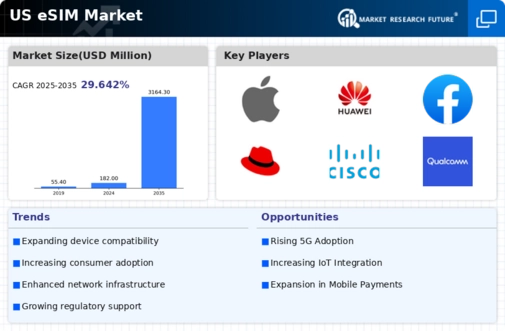Rising Demand for IoT Devices
The increasing proliferation of Internet of Things (IoT) devices is a notable driver for the esim market. As more devices become interconnected, the need for efficient and flexible connectivity solutions grows. In the US, the number of IoT devices is projected to reach 30 billion by 2025, which indicates a substantial market opportunity for esim technology. This trend suggests that consumers and businesses alike are seeking seamless connectivity without the constraints of traditional SIM cards. The esim market is likely to benefit from this shift, as eSIM technology allows for easier management of multiple devices and subscriptions, thereby enhancing user experience and operational efficiency.
Increased Focus on Sustainability
The growing emphasis on sustainability and environmental responsibility is emerging as a key driver for the esim market. As consumers and businesses become more environmentally conscious, the demand for solutions that reduce electronic waste is rising. eSIM technology, which eliminates the need for physical SIM cards, aligns with these sustainability goals. In the US, initiatives aimed at reducing plastic waste are gaining traction, and eSIMs present a viable alternative. This shift towards eco-friendly solutions may encourage more companies to adopt eSIM technology, thereby fostering growth in the esim market as organizations seek to enhance their sustainability profiles.
Consumer Preference for Flexibility
Consumer preferences are shifting towards more flexible mobile connectivity options, which is driving growth in the esim market. Users increasingly favor the ability to switch carriers without needing to physically change SIM cards. This flexibility is particularly appealing to frequent travelers and tech-savvy individuals who value convenience. According to recent surveys, approximately 60% of consumers in the US express a desire for more control over their mobile plans, which aligns with the capabilities offered by eSIM technology. As this trend continues, the esim market is expected to expand, catering to the evolving demands of consumers seeking adaptable and user-friendly solutions.
Regulatory Changes Favoring eSIM Adoption
Recent regulatory changes in the telecommunications sector are likely to facilitate the growth of the esim market. The US government has been actively promoting policies that encourage innovation and competition within the telecom industry. These regulations may include provisions that simplify the process for consumers to switch carriers and adopt eSIM technology. As a result, the esim market could experience increased adoption rates, as consumers find it easier to transition to eSIM solutions. This regulatory support appears to create a favorable environment for the expansion of eSIM technology, potentially leading to a more competitive and dynamic market landscape.
Advancements in Mobile Network Infrastructure
The ongoing advancements in mobile network infrastructure, particularly with the rollout of 5G technology, are significantly impacting the esim market. Enhanced network capabilities enable faster data speeds and improved connectivity, which are essential for the effective utilization of eSIM technology. In the US, 5G adoption is anticipated to reach 50% of mobile subscriptions by 2025, creating a conducive environment for eSIM deployment. This synergy between 5G and eSIM technology suggests that as network infrastructure improves, the adoption of eSIM solutions will likely accelerate, further driving growth in the esim market.























Leave a Comment